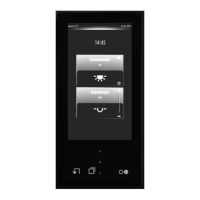Art. No. SC 1000 KNX
Automatic transmission
On automatic transmission of the command value telegrams, a distinction is made with regard
to the type of control...
- Continuous PI control:
In case of a continuous PI control, the room temperature controller calculates a new
command value periodically every 30 seconds and outputs it to the bus via a
1-byte value object. The change interval of the command value can be determined in
percent according to which a new command value is to be output on the bus via the
"Automatic transmission on change by..." parameter in the "Room temperature control ->
Controller general -> Command values and status output" parameter node. The change
interval can be configured to "0" so that a change in the command value will not result in an
automatic transmission.
In addition to the command value output following a change, the current command value
value may be periodically transmitted on the bus. In addition to the times when changes
are to be expected, other command value telegrams will be output according to the active
value after a configurable cycle time. This ensures that during a periodic access control of
the command value in servo drive or in the addressed switching actuator, telegrams are
received within the control interval. The time interval predetermined by the "Cycle time for
automatic transmission..." parameter parameter should correspond to the control interval in
the actuator (cycle time in the controller is preferably to be parameterized smaller). The "0"
setting will deactivate the periodic transmission of the actuating variable.
With continuous PI control it must be noted that if the cyclical and the automatic
transmission are both deactivated, no command value telegrams will be transmitted in case
of a change!
- Switching PI control (PWM):
In case of a switching PI control (PWM), the room temperature controller calculates a new
command value internally every 30 seconds. In this feedback control, however, the update
of the command value takes place, if required, solely at the end of a PWM cycle. The
parameters "automatic transmission on change by..." and "Cycle time for automatic
transmission..." are not enabled with this control algorithm. The parameter "Cycle time of
the switching command value..." defines the cycle time of the PWM command value signal.
- 2-point control:
In case of a 2-point feedback control, the room temperature and thus the hysteresis values
are evaluated periodically every 30 seconds, so that the command values, if required, will
change solely during these times. The "Automatic transmission on change by..." parameter
is not enabled as this control algorithm does not calculate continuous command values.
In addition to the command value output following a change, the current command value
value may be periodically transmitted on the bus. In addition to the times when changes
are to be expected, other command value telegrams will be output according to the active
value after a configurable cycle time. This ensures that during a periodic access control of
the command value in servo drive or in the addressed switching actuator, telegrams are
received within the control interval. The time interval predetermined by the "Cycle time for
automatic transmission..." parameter parameter should correspond to the control interval in
the actuator (cycle time in the controller is preferably to be parameterized smaller). The "0"
setting will deactivate the periodic transmission of the actuating variable.
Command value limit
Optionally a command value limit can configured in the ETS. The command value limit allows
the restriction of calculated command values to the range limits "minimum" and "maximum". The
limits are permanently set in the ETS and, if command value limitation is active, can be neither
undershot or exceeded during device operation. It is possible, if available, to specify various
limiting values for the basic and additional stages and for heating and cooling.
Page 207 of 347
Software "Smart Control 501511"
Functional description

